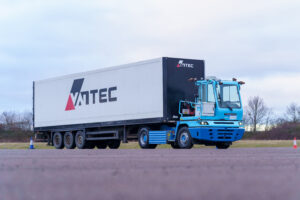StreetDrone’s mission is to enable low-speed autonomous vehicles to work for the benefit of people as soon as possible, and as such we’re always looking for safe ways to advance the deployment of this technology.
Utilising connectivity (whether it’s 4G, 5G or beyond) will be essential to getting autonomous vehicles (AVs) onto both public and private roads, today and in the near future. Connectivity in this context means that the vehicle can communicate with infrastructure and a connected web of tools, to give it help where needed. This is where StreetDrone will be using teleoperation (the control of a device or machine remotely) to great effect.
All autonomous vehicles (including vehicles fitted with ADAS systems like lane-keeping) operate within an Operational Design Domain (ODD – see our blog here), which sets out the conditions under which the vehicle can operate autonomously, tailored to a specific system. This includes weather conditions (light levels, rain, levels of standing water and much more) alongside hazards and obstacles the autonomous system can safely navigate. For example, in current production vehicles, RADAR-assisted Adaptive Cruise Control is designed for use on multi-lane highways, and under driver supervision. The ODD constrains where such technology can be used.
Taking forward the “limitations” of an ODD, imagine a typical urban route: a vehicle might encounter unexpected roadworks, sudden torrential rain, or broken traffic lights. Similarly, at any logistics depot or airport, other human-driven vehicles can offer up unexpected behaviour and new challenges. Depending on the autonomous system, it might not know what to do in these situations. If we wait until all routes and edge cases can be included in an ODD, we might be waiting a long time to deploy autonomous vehicles on the road. Reaching the high levels of autonomy required to remove safety drivers (the latter proving essential if we want to build profitable business models using autonomous technology) is extremely hard if a “computer” has to manage the whole process. This is where humans can still offer assistance, through teleoperation, to make autonomous vehicles available sooner.
So how does it work?
The vehicle is connected securely over cellular networks to a physical “driver station”, miles away from the vehicle’s route. At this driver station (designed in line with StreetDrone’s safety standard), a trained human operator sits at the wheel in front of screens of camera views and vehicle information.
When the autonomous vehicle encounters something outside it’s ODD, it can pull to a gentle stop and a human can take over via teleoperation, and complete the driving task until the vehicle can be placed into autonomous mode again. This could also include the autonomous system suggesting a decision, and a human approving it or taking over.
Teleoperation offers benefits beyond completing complex routes safely.
Teleoperation provides efficient way to run a fleet of vehicles, having one “operator” responsible for the management of multiple vehicles at one time. It also allows us to bridge the gap towards fully autonomous driving, while deploying safe autonomous vehicle services in the meantime. Teleoperation has immediate benefit in off-highway applications and will be used to develop technology and regulations for on-road use in the UK.
Progress in Teleoperation
We are already bringing these exciting benefits to reality. Through the “5G CAL” project at Nissan’s Sunderland manufacturing plant, StreetDrone are deploying connected and autonomous logistics vehicles to the site. In partnership with Voysys, we’re utilising 5G to deploy teleoperation to assist the vehicles when encountering anything outside their ODD, and keeping logistics runs on schedule.
To find out more about StreetDrone’s role in 5G CAL and our work with teleoperation, drive-by-wire or autonomous software, please get in touch.




